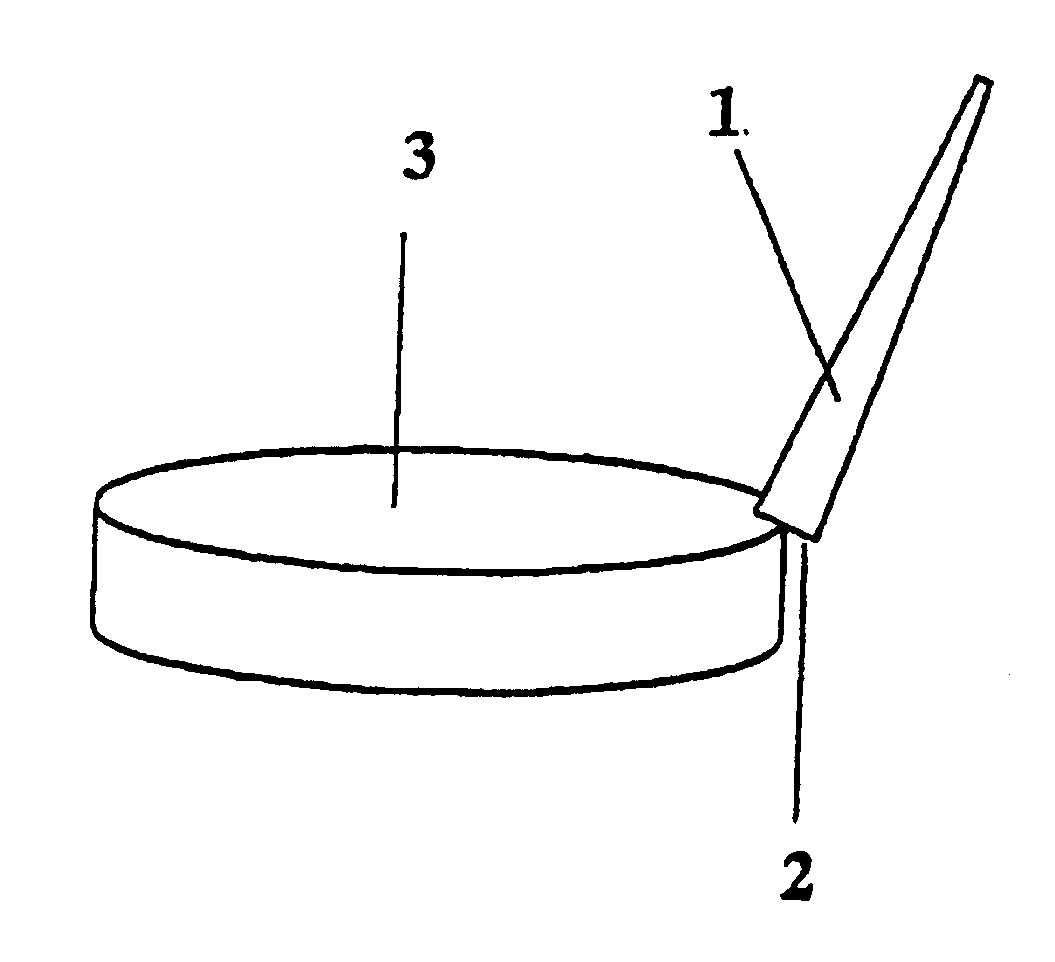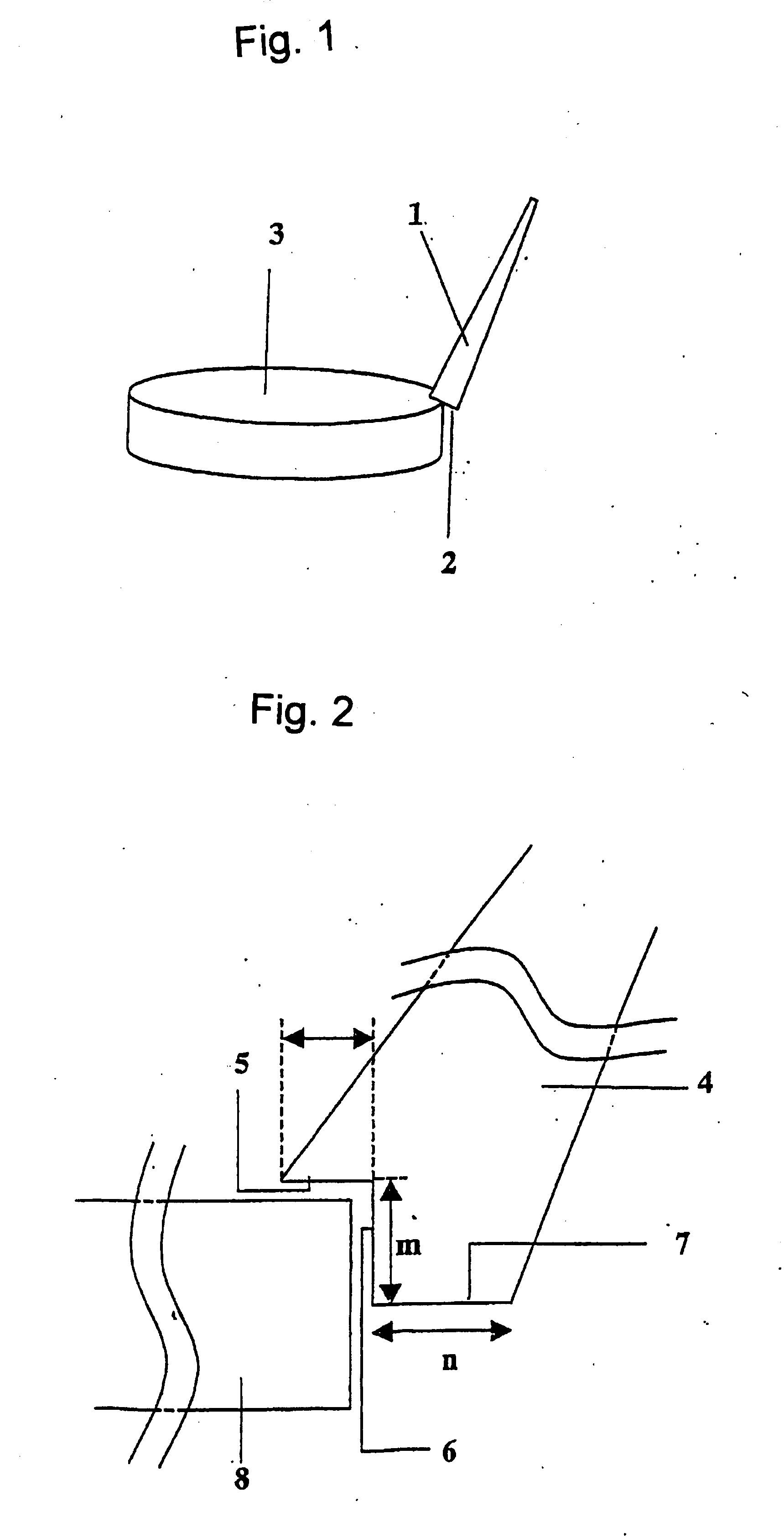[0023] In the present invention, further, the photopolymerizable and curable composition containing the photochromic compound is blended with a
phosphorus-containing photopolymerization initiator as a photopolymerization initiator. Upon effecting the curing by the
irradiation with the active energy
ray which is so adjusted that the
relative intensity thereof exhibits the above profile, the curing is completed within short periods of time while effectively suppressing the photochromic compound contained in large amounts in the curable composition from being deteriorated by light, and a high
molecular film is homogeneously formed on the curved surfaces of the substrate. That is, the
phosphorus-containing photopolymerization initiator generally reacts not only with the
ultraviolet rays but also with active energy rays of wavelengths in a visible light region of not shorter than 400 nm to undergo the cleavage thereby to initiate the
radical polymerization reaction. Even when the photopolymerizable and curable composition is blended with the photochromic compound at a
high concentration, therefore, the
radical polymerization reaction is initiated by the
irradiation with active energy rays of which the
relative intensity profile is adjusted as described above so as to have a decreased relative intensity in the region of
ultraviolet rays where the photochromic compound is excited without, therefore, affected by the photochromic compound. Therefore, the
polymerization and curing are quickly effected up to the interior of the coated layer of the photopolymerizable and curable composition while effectively avoiding the photochromic compound from being deteriorated by light. After cleaved, further, the phosphorus-containing
polymerization initiator does not absorb visible light due to its own photo-bleaching effect and, hence, triggers the
initiation reaction successively even in the direction of depth of the coated layer, so that the coated layer is homogeneously cured even up to the interior thereof.
[0024] Here, the relative intensity of the active energy
ray stands for a ratio of area intensities of the active energy rays in the wavelength regions of when the total area intensity of the active energy rays of the region of 200 to 500 nm is regarded to be 100%. The relative intensity profile of the active energy rays can be easily adjusted by permitting the active energy rays containing ultraviolet rays to pass through a filter (e.g., hard soda glass) that works to decrease the wavelength components of shorter than 300 nm.
[0025] According to the production method of the present invention as described above, the photochromic compound is effectively avoided from being deteriorated by light, and is quickly and homogeneously cured up to the interior, making it possible to effectively avoid the dropping of the curable composition that is applied onto the substrate and, hence, to form, on the surfaces of the substrate, a photochromic high molecular film featuring uniform thickness and containing the photochromic compound at a
high concentration.
[0026] According to the present invention, further, it is desired to use a photopolymerization initiator other than the phosphorus-containing photopolymerization initiator together with the phosphorus-containing photopolymerization initiator. That is, the above-mentioned phosphorus-containing photopolymerization initiator works as an interior curing
polymerization initiator while the other photopolymerization initiators trigger the
initiation reaction with ultraviolet rays. Near the surface of the coated layer of the curable composition, therefore, the other photopolymerization initiators are little affected by
oxygen and work as surface-curable polymerization initiators. That is, even when the curing is conducted in an
atmosphere containing
oxygen in
trace amounts (several tens to several hundreds of ppm), use of the phosphorus-containing photopolymerization initiator together with other photopolymerization initiators makes it possible to form a photochromic high molecular film which is homogeneously cured up to the interior from the surface. In other words, the allowable range of
oxygen concentration is expanded in an
atmosphere where the polymerization and curing are conducted. As a result, the
atmosphere such as substitution with
nitrogen can be adjusted under mild conditions, the polymerization and curing can be completed within short periods of time, and the curable composition applied onto the substrate is effectively avoided from dripping, which is very advantageous for preventing the occurrence of dispersion in the thickness of the photochromic high molecular film and the occurrence of wrinkles. Besides, the high molecular film exhibits an enhanced surface
hardness, which is advantageous for enhancing the intimate adhesion between the high molecular film and the substrate or the hard coated layer.
[0031] That is, according to the production method of the invention, the curing is effected within short periods of time effectively suppressing the dripping of solution during the curing or inhomogeneous polymerization. It is therefore allowed to form a homogeneous photochromic coating having a uniform thickness on the curved surfaces of the substrate. Accordingly, a difference between the spherical
refractive index of the substrate and the spherical refractive power of the laminate becomes smaller than ±0.5 diopters. This means that high optical characteristics possessed by the substrate are maintained without almost being impaired. Besides, despite of being formed on the curved surfaces, the entire high molecular film has a uniform thickness. The degree of uniformity of the film thickness is as very high as not larger than 7% of the average film thickness (ΔW / Wav≦0.07). It is relatively easy to form a high molecular film having a uniform thickness on a plane. With the conventional technology of forming a film by using a coating agent, however, it is not allowed to form a uniform and thin high molecular film on the curved surfaces.
 Login to View More
Login to View More 


